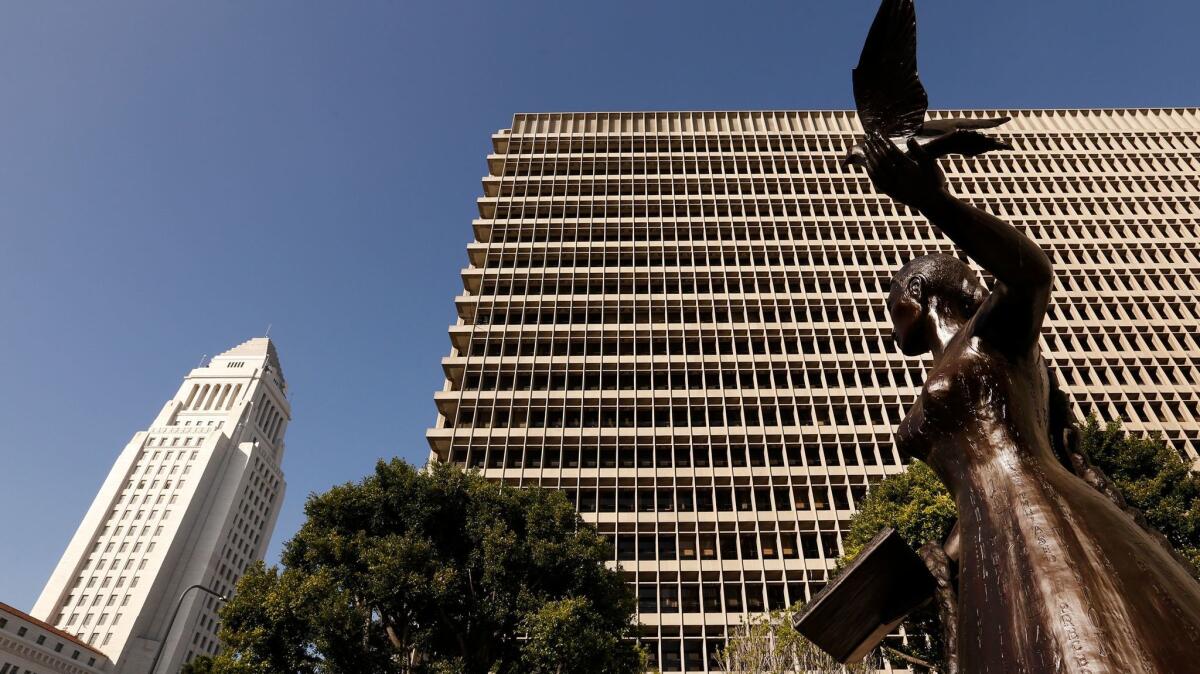Many L.A. County courthouses are seismically unsafe, study finds

- Share via
A new study showed more than 100 courthouses in the state — including many in Los Angeles County — could collapse and cause “substantial” loss of life in a major earthquake.
“We can’t be in a position after a major earthquake having the public say what did you do and why didn’t you sound the alarm,” Court of Appeal Justice Brad H. Hill, head of a state committee on courthouses, said during a meeting in San Francisco. “We are sounding the alarm.”
The committee Hill heads advises the Judicial Council, the policy-making body for state courts. The group asked for the new report, an update of a previous study, and discussed it during its regularly scheduled session.
The report found that the Superior Court in Glendale, built in 1956, has the highest risk rating of any courthouse in California.
Others near the top of the list of buildings in peril include the Stanley Mosk Courthouse and Clara Shortridge Foltz Criminal Justice Center in downtown Los Angeles, the Pasadena municipal courthouse, and courthouses in Beverly Hills and Burbank.
They were among 145 courthouses that the study found would sustain substantial structural damage, including the likelihood of partial collapse, and create “substantial” risk to life during a major quake.
The cost of retrofitting these buildings range from $200 million for the Shortridge Foltz center to $140 million for one wing of the Stanley Mosk Courthouse.
Judicial leaders will next try to determine more precisely the cost of retrofitting the highest risk buildings and try to get money for the work from Sacramento.
State lawmakers took away a $1.4-billion court construction fund raised by court fees and fines to spend on other priorities during the recession.
“We are in fairly dire straits, but we need to move forward,” Hill said during an interview. “We are asking the governor and the Legislature to return that money.”
Los Angeles Superior Court Judge William F. Highberger, a committee member, acknowledged that the state could not afford to fix all the courthouses, but said “we owe it to the people who use the courthouses ... to try to do our best to reduce the risk of death and serious injury to the people.”

Stephen Nash, court executive officer for the Superior Court in Contra Costa County, noted at the meeting that he works in one of the courthouses rated high-risk.
“We are sitting on a time bomb,” Nash said. “We are watching the clock tick, and our ability to do anything has been taken away.”
Nash said he found it “alarming” to look into the eyes of the public using the courthouse and the staff and judges and “know that it is cross-your-fingers” time.
During the last 10 years, the judiciary has built 30 new courthouses in California, 26 of them to replace buildings at risk of collapse.
Critics of court leadership lambasted the early construction program as wasteful and the new courthouses as unnecessarily lavish. Some of the them won design awards. Now each project must be carefully assessed for costs, Hill said prior to the meeting.
“We tell architects we are not here to win design awards and not here to have marble and exotic woods,” Hill said. “We are here to have courthouses that will last 80 years. We can’t afford the courthouses of the past.”
Hill pointed to a new courthouse in Los Banos in the Central Valley. It is a prefab building with laminate floors, not wood, and no granite or marble, Hill said. He said court users love it.
Aside from earthquake safety, accessibility for the disabled and security needs top the list of concerns about courthouses. Hill said some courts have no elevators, and disabled people have to be carried up stairs.
The courts are not the only state buildings with high seismic risks. State universities also have an inventory of troubled buildings, said Clifford Ham, principal architect for the Judicial Council.
He said the seismic ratings were based on nationally recognized standards that look at what would happen in a major earthquake, the kind that happens every 1,000 years but “could happen tomorrow.”
Hill mentioned a courthouse in Napa that partially collapsed during a 2014 quake.
“It happened at 2 a.m.,” he said. If it had been 2 in the afternoon, it would have been devastating.”
Twitter: @mauradolan
UPDATES:
4:30 p.m.: This article was updated with details from the advisory committee meeting.
11:55 a.m.: This article was updated comments from a justice who heads the advisory committee.
This article was originally published at 9:20 a.m.
More to Read
Sign up for Essential California
The most important California stories and recommendations in your inbox every morning.
You may occasionally receive promotional content from the Los Angeles Times.














